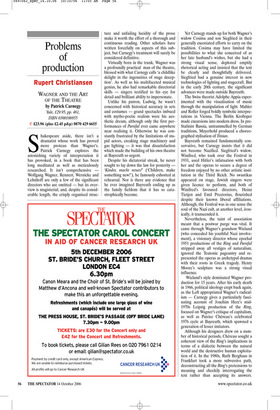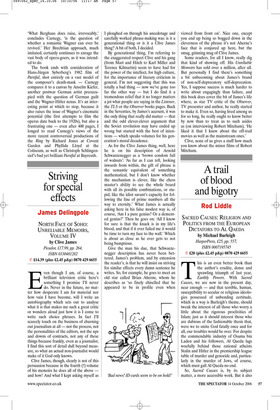Problems of production
Rupert Christiansen
WAGNER AND THE ART OF THE THEATRE by Patrick Carnegy Yale, £29.95, pp. 461, ISBN 0300106955 ✆ £23.96 (plus £2.45 p&p) 0870 429 6655 Shakespeare aside, there isn’t a dramatist whose work has proved more protean than Wagner’s. Patrick Carnegy explores the astonishing variety of interpretation it has provoked, in a book that has been long meditated as well as meticulously researched. It isn’t comprehensive Wolfgang Wagner, Rennert, Wernicke and Lehnhoff are only a few of the significant directors who are omitted — but its overview is magisterial, and, despite its considerable length, the crisply organised struc ture and unfailing lucidity of the prose make it worth the effort of a thorough and continuous reading. Other scholars have written forcefully on aspects of this subject, but Carnegy’s treatment will surely be considered definitive.
Virtually born in the trunk, Wagner was a profoundly practical man of the theatre, blessed with what Carnegy calls ‘a childlike delight in the ingenuities of stage deception’. As well as his multifaceted musical genius, he also had remarkable directorial skills — singers testified to his eye for detail and brilliant ability to impersonate.
Unlike his patron, Ludwig, he wasn’t concerned with historical accuracy in sets and costumes — grand spectacles imbued with mytho-poetic realism were his aesthetic dream, although only the first performances of Parsifal ever came anywhere near realising it. Otherwise he was constantly frustrated by the limitations of stupid actors, creaking stage machinery and gas lighting — it was that dissatisfaction which made the building of his own theatre at Bayreuth so urgent.
Despite his dictatorial streak, he never sought to lay down the law for posterity — ‘Kinder, macht neues!’ (‘Children, make something new!’), he famously exhorted at rehearsal. Nor is there any evidence that he ever imagined Bayreuth ending up as the family fiefdom that it has so catastrophically become. Yet Carnegy stands up for both Wagner’s widow Cosima and son Siegfried in their generally excoriated efforts to carry on the tradition. Cosima may have limited the possibilities to what she conceived of as her late husband’s wishes, but she had a strong visual sense, deplored emptily rhetorical acting and insisted that the text be clearly and thoughtfully delivered. Siegfried had a genuine interest in new technologies of lighting and stagecraft. But in the early 20th century, the significant advances were made outside Bayreuth.
The Swiss theorist Adolphe Appia experimented with the visualisation of music through the manipulation of light. Mahler and Roller forged boldly symbolic interpretations in Vienna. The Berlin Krolloper made excursions into modern dress. In preStalinist Russia, untrammelled by German traditions, Meyerhold produced a choreographed stylisation of Tristan.
Bayreuth remained fundamentally conservative, but Carnegy insists that it did not become Nazified. Siegfried’s widow, Winifred, who took over the Festival in 1931, used Hitler’s infatuation with both her and the operas to secure a degree of freedom enjoyed by no other artistic institution in the Third Reich. No swastikas appeared on stage, Jewish singers were given licence to perform, and both of Winifred’s favoured directors, Heinz Tietjen and Emil Preetorius, flourished despite their known liberal affiliations. Although, the Festival was in one sense the soul of the Nazi cult, at another level, ironically, it transcended it.
Nevertheless, the taint of association meant that a postwar purge was vital. It came through Wagner’s grandson Wieland (who concealed his youthful Nazi involvement), a visionary director whose epochal 1951 productions of the Ring and Parsifal stripped away all vestiges of naturalism, ignored the Teutonic pageantry and represented the operas as archetypal dramas with their roots in Greek tragedy. Henry Moore’s sculpture was a strong visual influence.
Wieland’s style dominated Wagner production for 15 years. After his early death in 1966, political ideology crept back again, as the Left appropriated Wagner’s radicalism — Carnegy gives a particularly fascinating account of Joachim Herz’s mid1970s Leipzig production of the Ring, focused on Wagner’s critique of capitalism, as well as Patrice Chéreau’s celebrated 1976 cycle at Bayreuth, which spawned a generation of lesser imitators.
Although his designers drew on a number of historical periods, Chéreau sought a coherent view of the Ring’s implications in terms of a dialectic between the natural world and the destructive human exploitation of it. In the 1980s, Ruth Berghaus in Frankfurt took a more subversive path, deconstructing all the Ring’s pretensions to meaning and cheekily interrogating the text rather than accepting its answers. ‘What Berghaus does raise, irrevocably,’ concludes Carnegy, ‘is the question of whether a romantic Wagner can ever be revived.’ Her Brechtian approach, much imitated, certainly continues to enrage the vast body of opera-goers, as it was intended to do.
The book ends with consideration of Hans-Jürgen Syberberg’s 1982 film of Parsifal, shot entirely on a vast model of the composer’s death-mask — Carnegy compares it to a canvas by Anselm Kiefer, another postwar German artist preoccupied with the question of German guilt and the Wagner-Hitler nexus. It’s an interesting point at which to stop, because it also raises the issue of Wagner’s cinematic potential (the first attempts to film the operas date back to the 1920s), but also a frustrating one — even after 400 pages, I longed to read Carnegy’s views of the more recent controversial productions of the Ring by Richard Jones at Covent Garden and Phyllida Lloyd at the Coliseum, as well as Christoph Schlingensief’s bad yet brilliant Parsifal at Bayreuth.



































































































 Previous page
Previous page